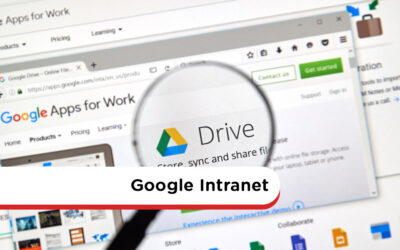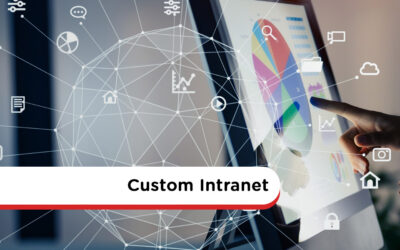The Intranet Design Guide
Not sure where to get started in designing your intranet?
Check out our easy step-by-step guide below.
Let us guide you through the process.

Intranet Design Made Simple

Deciding to go ahead with an intranet was the easy part, right? After all, whether it’s improved communications, more streamlined processes, or easier access to information, the intranet ticks all the boxes.
However, designing your intranet can be a daunting task.
There are many decisions to be made around the type of intranet, hosting options, organization, structure, plus content, and design. With so much to think about, it can be tough to get started.
And if technology isn’t really your thing, it can be even harder to kick-start your intranet. That’s where this intranet design guide comes into play.
So, if widget, cache, and malware sound like another language, then this guide is for you! Written in simple-to-understand and jargon-free terms, the design guide is non-technical. And where technical language is unavoidable, we clearly define what we mean.
This guide will show you that designing an intranet is a simple task. In fact, it’s so easy, you won’t need IT backup or a college degree in computers!
Click here to download this guide in PDF format
Step-By-Step Intranet Design Support
The guide is a comprehensive resource, covering everything you need to know about intranets. We provide helpful insights at every stage, from different intranet types and hosting options to security and training.
And we also look at all the latest intranet design best practices. This resource includes lots of practical examples and visuals that will excite and inspire you.
What’s Included In This Intranet Design Guide
Who Should Read This Guide
The design guide is an essential resource for anyone planning to implement a new intranet. It’s also required reading if you are looking to revitalize, revamp, or refresh an existing intranet.
Perhaps you are in the market for an intranet provider to help you realize your vision. The design guide can help you make a winning selection.
Written for the non-technical person, this resource will also support HR or Marketing staff tasked with implementing an intranet.
Why Intranet Design Is So Important
Before we move on, it’s essential to understand why intranet design is so important.
Your intranet’s overall look and feel has the power to grab users’ attention and draw them in. It can spark creativity and foster collaboration. It can connect employees and turn the everyday task into something engaging and fun.
However, the stakes are high. A poorly designed intranet will have the opposite effect. A confusing, overloaded, and ugly intranet will see staff switch off. It’s a wasted opportunity as well as investment.
With so much to lose, getting your intranet design right has to be a priority.
No Two Intranets Are Alike
When it comes to design, there is no one-size-fits-all intranet solution. Sure, there will be similarities. It could be layout, functionality, or scope. However, every organization is different, and so too is their intranet.
Furthermore, staff members will use the intranet differently depending on their job roles and team functions.
Employees use the intranet mainly to source information or collaborate with colleagues. Managers, however, use the intranet to engage workers with targeted communications.
Your intranet design needs to satisfy all the varying needs of employees.
And it also needs to meet the challenges of the modern digital workplace.
The global Covid-19 pandemic has fast-tracked the shift towards remote working. Companies have to pivot and rethink how they engage with their workforce in today’s rapidly changing environment.
And they need to ensure employees have the tools available to remain productive even when working from home.
A mobile intranet is a minimum requirement. In fact, it’s not so much a requirement as an expectation. Whether staff are on the go or working from home, they expect to continue working.
Versatile and flexible, the intranet is capable of meeting these competing demands. And your intranet design should make this vision a reality.
Intranet Templates Make Design Easy
And if you are pushed for time, then intranet design templates could be the perfect solution. This guide takes you through all you need to know.
In short, intranet templates come with in-built coding plus a basic design and graphics. The setup wizard makes it quick and easy to implement your customized intranet. Upload your logo, branding, and corporate colors to really put your company stamp on the intranet. And the good news is the intranet provider has already extensively tested the functionality. And that’s one less major headache for you to worry about.
Therefore, design templates are a popular choice if you need to get your intranet up and running quickly.
Let Us Guide You
Use this guide to make your intranet deployment a smoother and quicker process.
Essential reading for those starting to deploy an intranet, this resource will also help businesses looking to revamp an existing intranet.
Either way, we understand the challenges that are involved. And you get the benefit of our experience as we guide you through the process from beginning to end.
So, let’s get started.
Intranet Design Infographic
If you would like an overview of our intranet design guide, we have created a PDF infographic file summarizing the main points available here.
Further Reading
This further reading list will be an invaluable resource as it takes you through everything you need to know. We give you the benefit of our considerable experience in developing intranets and provide simple, easy-to-follow explanations, insights and advice.
Use this list to explore the latest intranet design best practice principles. Find out how pre-built intranet templates could well be the solution every time-pressed business owner is looking for. Discover how to ensure your intranet design is mobile friendly and optimized for use on smartphones and tablets. And learn about how to make your intranet interactive and fun so that users readily engage with the platform making for a more efficient and effective workplace.
These are just some of the insights available in this category so why not have a browse or use the search functionality to explore more about intranet design. With our comprehensive knowledge bank, you’ll soon discover that designing an intranet isn’t the mammoth task that perhaps you first thought it was.
Off The Shelf Intranet: Pre-Built and Fully Developed
An off-the-shelf intranet refers to a pre-built intranet platform that comes with ready-to-use modules, templates, and features out of the box. These systems allow organizations to get started quickly without needing to build from scratch or invest heavily in custom development. The focus is on speed, ease of setup, and standard features that cover most common intranet use cases: document sharing, news feeds, staff directories, communication tools, etc.
While these solutions lack some of the deep customization of bespoke systems, they offer many advantages: faster time to go-live, lower upfront cost, predictable maintenance and support, frequent updates by vendor, and lower requirement for internal technical skills. They are especially useful for small-to-medium enterprises, or organizations that need a solid intranet quickly, without reinventing the wheel.
To make the most of an off-the-shelf intranet, organizations should choose a vendor that provides strong template options, flexible branding, modular features, good vendor support, and integrations with existing tools (e.g. MS-365, Google Workspace). It’s also wise to plan for user adoption, feedback, and ongoing content governance to ensure the intranet stays relevant and gets used.
CMS Intranet Software: Unleash The Power
In today’s fast-paced business environment, effective internal communication and collaboration are paramount. MyHub’s CMS intranet software offers a comprehensive solution to streamline these processes. By providing a centralized platform for content management, employees can easily create, edit, and share information without the need for extensive technical knowledge. This user-friendly approach ensures that all team members, regardless of their technical expertise, can contribute to and benefit from the intranet’s resources.
The software’s versatility extends beyond content creation. It integrates various tools that facilitate seamless collaboration among team members. Features such as instant messaging, shared calendars, and document sharing enable employees to work together efficiently, regardless of their physical location. This is particularly beneficial for organizations with remote or hybrid work models, as it ensures that all team members remain connected and engaged.
Furthermore, MyHub’s CMS intranet software is designed with scalability in mind. As organizations grow and evolve, the software can be customized to meet changing needs. Whether it’s adding new modules, integrating with other systems, or adjusting user permissions, the platform offers the flexibility required to adapt to an organization’s unique requirements. This scalability ensures that the intranet remains a valuable asset as the organization progresses.
How To Handle Employees With Bad Attitudes: 5 Practical Tips For Managers
Employees with bad attitudes can quietly undermine team morale and productivity, even if they perform their job tasks. These individuals often complain constantly, gossip, shift blame, or subtly resist leadership—behaviors that can poison the work environment if left unchecked. Recognizing the difference between someone occasionally voicing feedback versus someone chronically toxic is vital for managers.
To handle such situations, the article presents five practical strategies. First, document specific instances of negative behavior—unhelpful comments in meetings, undermining coworkers, or undermining authority—so discussions are grounded in fact. Next, have a private meeting (ideally with HR present) where you explain the concern, listen to their perspective, and frame expectations moving forward. From there, co-create an action plan with behavioral benchmarks and follow-up sessions. If the employee fails to change, formal warnings or termination may be necessary.
Beyond direct interventions, the article argues that a positive corporate culture helps deter negative attitudes from arising in the first place. Encouraging two-way communication, recognizing contributions, fostering belonging, caring for employee wellbeing, and celebrating collective wins all help build a resilient, engaged team. The message is clear: dealing with attitude issues early, fairly, and systematically protects team health and long-term performance.
Corporate Communication: What SMEs Need To Know
Effective corporate communication is crucial for SMEs aiming to build strong relationships with both internal and external stakeholders. The article emphasizes that clear and consistent messaging fosters trust, aligns team objectives, and enhances brand reputation. By understanding the nuances of corporate communication, SMEs can navigate challenges and seize opportunities for growth.
The piece delves into the two primary categories of corporate communication: internal and external. Internal communication encompasses interactions within the organization, such as between management and employees or among departments. Tools like intranets, team chats, and internal newsletters can facilitate this. External communication, on the other hand, involves engaging with customers, media, and the public, often through marketing materials, press releases, and social media channels.
To assist SMEs in refining their communication strategies, the article provides practical examples and best practices. It highlights the importance of tailoring messages to the audience, choosing the appropriate communication channels, and maintaining consistency across all platforms. By adopting these practices, SMEs can enhance their corporate communication efforts and achieve greater success in their endeavors.
Overcoming Communication Barriers: Key Skills and Practical Examples
Effective communication is vital for success in any organization. However, various barriers can impede the flow of information, leading to misunderstandings and decreased productivity. These barriers can be physical, such as noise or distance; cultural, like language differences or varying communication styles; or emotional, including fear or lack of trust. Recognizing these obstacles is the first step toward fostering a more communicative and cohesive work environment.
The article delves into specific barriers that organizations often face. For instance, physical barriers may include open office layouts that cause distractions or technological issues that hinder virtual communication. Cultural barriers might involve misinterpretations due to different cultural norms or language proficiency levels. Emotional barriers often stem from unresolved conflicts or lack of psychological safety, which can prevent individuals from expressing themselves openly.
To overcome these challenges, the article suggests several strategies. These include establishing clear communication protocols, promoting cultural awareness and sensitivity, providing training to improve communication skills, and creating an environment where feedback is encouraged and valued. By addressing these barriers proactively, organizations can enhance collaboration, reduce misunderstandings, and improve overall efficiency.
Simplify Project Tracking With 10 Tools That Keep Your Team Aligned
Project tracking is the practice of systematically monitoring the progress of tasks and deliverables against an established plan. By collecting real-time data and comparing it to expectations, project managers can spot delays or resource misalignments early—and take corrective action. This kind of visibility helps keep initiatives on schedule and in scope.
The article emphasizes how lacking clarity or slow internal communications are major contributors to project failures—citing that 39% of projects fail due to ambiguous objectives, and 33% cite communication issues. To tackle such challenges, the post recommends selecting project-tracking tools that centralize task lists, timelines, dependencies, and status updates in one place.
To help readers choose wisely, the article presents 10 tools that can support project tracking and team alignment. It also discusses how intranet-based tracking tools (like MyHub’s modules) can make collaboration smoother by embedding tracking within your internal network—reducing context-switching and improving adoption.
How to Overcome Idea Hoarding: Why Employees Keep Ideas to Themselves
Idea hoarding happens when employees tuck away insights or suggestions instead of sharing them. The article explores key reasons for this behaviour—fear of rejection or negative judgment, unclear or unrewarded submission processes, and lack of recognition. These issues stem from both psychological barriers and organizational design flaws—such as vague follow-up workflows or opaque decision environments.
To counteract idea hoarding, the piece argues for transparent communication. It describes how clear leadership, open decision-making, and regular feedback can create safer environments in which employees feel their contributions matter. This transparency isn’t just philosophy—it’s backed up by intranet platforms that make idea submission visible, let employees track the progress of their ideas, and offer forums or boards where ideas can be discussed openly.
Finally, it offers practical steps for organisations aiming to foster openness: establish clear idea submission rules; provide visible dashboards showing what ideas have been submitted and what stage of review they are in; showcase employee contributions; hold “open decision” or feedback sessions; and measure outcomes like number of ideas submitted, rate of implementation, and employee satisfaction related to being heard. These actions can remove friction, build trust, and improve engagement.
All About Teamwork: Understanding, Improving, and Celebrating Teamwork in the Workplace
Team collaboration is described as when two or more people work together toward a common goal through shared tasks, planning, and pooling knowledge. Modern businesses increasingly form cross-functional and virtual teams, making collaboration not just a “nice-to-have” but essential for innovation, quicker decisions, and improved outcomes. However, collaboration often fails due to unclear roles, communication breakdowns, and cultural silos.
To improve collaboration, the post outlines several actionable strategies. First, define and communicate clear goals so everyone understands what they’re working toward and what success looks like. Second, promote open communication—especially when encountering roadblocks. Tools like forums, instant messaging, and shared files are highlighted as ways to keep teams aligned. Third, structure meetings well (with agendas and action items), encourage all voices (including quieter ones), and document decisions to avoid misunderstandings.
The article also examines collaboration tools that support these behaviour changes and make teamwork smoother. Features like dedicated team channels, document sharing, shared calendars, feedback and comment tools, staff directories, and activity walls are mentioned as enablers. It also points out that smaller teams tend to collaborate more smoothly, and strong leadership (clarifying roles, encouraging participation, managing priorities) plays a key role.
Why Employee Engagement Goals Matter – And How To Achieve Them
Employee engagement goals are more than just feel-good statements—they’re essential business levers. Organizations often struggle with vague goals like “increase engagement,” but without clarity on what engagement means for them (better retention, enhanced customer satisfaction, reduced absenteeism, etc.), there is no roadmap to follow. Leadership buy-in and defining priorities are the starting points to make these goals meaningful.
To build engagement goals that deliver, the article recommends using best practices such as conducting employee surveys to get baseline data, using SMART (Specific, Measurable, Attainable, Relevant, Time-bound) targets, and ensuring goals are tied to business outcomes. Running surveys also gives voice to employees and helps uncover what truly matters to them.
Measurement is key. The article lays out possible success metrics like turnover/retention rates, absenteeism, employee-net-promoter score, customer satisfaction, productivity, and qualitative feedback. Importantly, the results from surveys and goals must be acted upon—leaders must close the feedback loop and track progress over time, not just collect data.
Employee Feedback Loops: A Simple Tool to Improve Workplace Culture
A feedback loop is a continuous, two-way communication cycle between employees and leadership, where employees provide honest input and leaders act on that feedback, then report back on changes made. This process helps employees feel heard and valued, which is increasingly important in workplaces where only about 30% of staff feel their opinions count.
These loops typically follow four main stages: collecting feedback (openly or anonymously), analyzing responses to spot trends, taking action based on what’s been learned, and communicating back to everyone involved about what changes are being made. When done well, it builds transparency, trust, and a more responsive workplace culture.
The positive effects are broad: improved employee engagement, better collaboration, reduced internal friction, and a workforce that is more adaptable and motivated. Feedback loops also help in proactively addressing issues before they escalate into conflict, and in fostering a sense of ownership among employees. To succeed, the article recommends clarifying purpose, using safe feedback channels, ensuring feedback is actionable, and maintaining regular, consistent dialogue.
Mobile Intranet Apps: Top 10 Applications and 25 Ways to Use Them
A mobile intranet is a smartphone-optimized version of a company’s internal network — not just a mobile view of the desktop site, but a dedicated app experience crafted for on-the-go employees. It lets users securely access news feeds, chat, documents, workflows, and directories from their phones with tap-friendly design and streamlined interfaces.
The article lays out the benefits: better internal communication through push notifications, news feeds, and real-time chat; higher productivity and efficiency by allowing workflows like form submissions, approvals, or document access anytime; and enhanced customer service, especially for field staff, by giving them tools to resolve issues quickly with full information access on the go.
It then presents essential features — push notifications, team chat with #channels, news & update feeds, employee directory, advanced mobile search, security and access controls, and automated mirroring of the desktop intranet’s content. The article also lists 10 leading mobile intranet app platforms and wraps with how to plan and build (or select) a mobile intranet app.
Easy Intranet: Successful Business Intranets Keep It Simple
The core premise of the article is that the most successful intranets are often the simplest ones. A user-friendly, intuitive intranet encourages adoption, reduces training friction, and becomes a central tool for employees rather than a burdensome system. The post emphasizes that “easy” intranets need not be basic—they can still deliver powerful features while minimizing complexity for both users and administrators.
In detailing what makes an intranet easy, the article outlines a number of features that matter: quick setup using drag-and-drop templates, modular systems (so admin picks only needed features), mobile optimization, robust security, and smooth integration with existing systems. The idea is to remove technical barriers so non-technical teams can get up and running swiftly.
Finally, it discusses how such intranets remain maintainable over time. By offering ongoing updates, built-in improvements, transparent pricing, and customer support (including design services for those short on time), the platform positions itself as a long-term partner, not just a one-off setup
USA Intranet – The Top Intranet Solutions In The United States
The “USA Intranet – The Top Intranet Solutions in the United States” article serves as a guide for organizations looking to select the best intranet providers operating in the U.S. market in 2025. It begins by stressing the importance of defining intranet purpose, setting goals, and establishing governance structures before choosing a provider. Clarity early on helps ensure the selected intranet aligns with company culture and solves real employee communication issues.
Next, the article outlines key strategy elements such as intuitive site navigation, content management, mobile accessibility, and strong information architecture. These are presented as essential foundations to ensure any intranet is usable, inclusive, and secure — especially for workforces that include remote or distributed staff. The piece underscores that a good intranet should reduce friction in workflows, support collaboration, and serve as a reliable knowledge-hub.
Finally, it presents a curated list of the top 10 intranet solutions in the USA, based on criteria including ease of use, integrations, UX design, pricing, and support. Platforms like MyHub are featured, alongside others such as Workvivo, Simpplr, Unily, Interact, ThoughtFarmer, Blink, and more. This gives readers a detailed comparison to help narrow down which solution suits their size, budget, and needs best.
Google Intranet: Unleash The Power Of Google Workspace In Your Intranet
Google Workspace has evolved into a staple for businesses of all sizes, providing cloud-based tools like Gmail, Google Docs, Sheets, Slides, Calendar, and Google Drive. These tools offer real-time collaboration, easy sharing, and ubiquitous access. When combined with a modern intranet, Google Workspace becomes even more powerful—bringing together document editing, communication, workflows, and collaboration in a unified platform.
MyHub’s Google-intranet model allows embedding Google documents (Docs, Sheets, etc.) directly within the intranet, meaning users don’t need to toggle between multiple apps. Permissions and document updates are managed in real time, ensuring everyone is always working from the latest version. This integration also supports single sign-on and unified access—reducing login fatigue and improving usability.
The benefits are broad: more efficient internal communication (news, forms, alerts), increased employee engagement through simplified workflows, better knowledge management by centralizing files and context, and cost savings from reduced tool overlap. MyHub also highlights that using Google Workspace together with their intranet increases scalability, reliability (cloud backups), automatic updates, and flexibility for hybrid-or remote work.
Custom Intranet: The 5 Best Intranet Builder For 2025
A custom intranet allows organizations to go beyond basic out-of-box solutions by tailoring features, branding, layout, and integrations to their own needs. Unlike generic intranets, custom ones support specialized workflows, employee engagement, and knowledge management in ways that align closely with the organization’s culture and goals.
The article lists 5 top intranet builder solutions for 2025—platforms that offer drag-and-drop design, strong theming and branding options, integrations with tools like Microsoft 365 or Google Workspace, mobile support, news feeds, collaboration tools, and search functionality. These builders vary in price, flexibility, and level of vendor support.
It also provides guidance for choosing the right custom intranet: assessing business needs, listing “must-have” versus “nice-to-have” features, evaluating usability, vendor reputation, scalability, cost models, and customization ability. The goal is to pick a platform that balances flexibility with ease of use.














